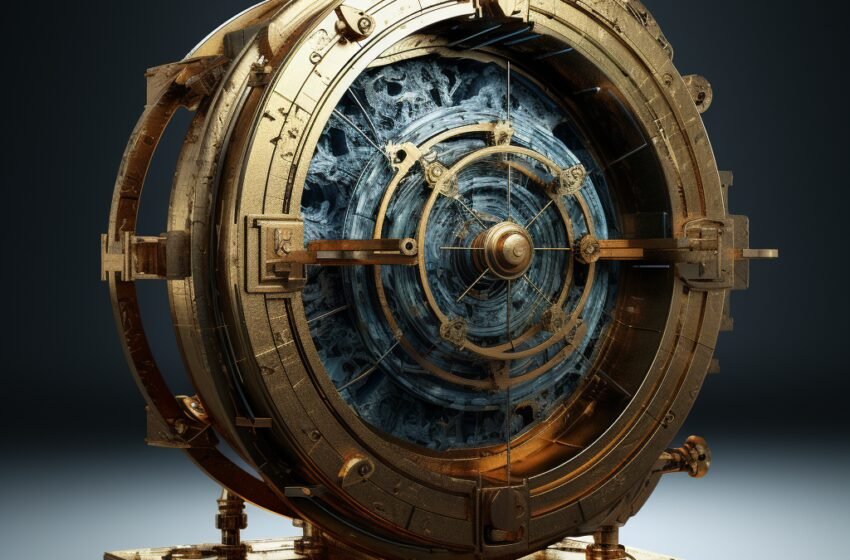Decoding the Antikythera Mechanism: Unraveling the Secrets of Ancient Technology

In the year 1900, the tranquil waters near the island of Antikythera bore witness to a momentous event that would ignite the spark of underwater archaeology. Amidst the aftermath of a storm, Greek divers hailing from the island of Symi sought refuge and respite near the shores of Antikythera. Clad in cumbersome copper and brass helmets, and heavy canvas suits, they embarked on a routine expedition in search of natural sponges, unaware of the extraordinary discovery that awaited them. Elias Stadiatis, one among the divers, emerged from the depths of the sea, his expression fraught with a mixture of awe and trepidation. His words, trembling and fragmented, spoke of a chilling encounter— he had seen a “heap of dead naked people” strewn across the ocean floor ! Little did he realize, he had stumbled upon a treasure trove of ancient artifacts, hidden beneath the waves for centuries.

The heap of ‘dead naked people’ were actually marble sculptures scattered amidst an old Greek shipwreck – they were silent sentinels of a forgotten past. Prompted by the magnitude of their find, archaeologists embarked on the first major underwater excavation in history. Though the diverse did not know it at that point of time, they had unveiled a window into the past, by illuminating the mysteries of ancient seafaring and the vibrant cultures that once thrived along the shores of the Mediterranean.
The most mysterious and significant finding of the wreckage was an unidentifiable “lump” of corroded metal and wood. The archaeologists of that time were more interested in the marble statues than this seemingly useless piece of junk. It was not until the researcher Valerios Stais chanced upon it, that this unique artifact finally received the attention that it much deserved. Valerios Stais first theorized the device to be an astronomical clock. However, prevailing scholarly opinion leaned towards skepticism, deeming it prochronistic. The complexity of the mechanism appeared to surpass the technological aptitude of its contemporary era. This notion raised questions regarding its origin, as it seemed improbable that such marvellous craftsmanship could have coexisted with the other relics unearthed from the same archaeological site.

Historical records suggested that intricate gears akin to those found in the Antikythera Mechanism shouldn’t have existed in ancient Greece or any other contemporary civilization. The anachronistic nature of the discovery stirred considerable debate among historians and archaeologists, fueling intense controversy. Historians believed that it was simply not possible for such an advanced device to have been engineered by the seemingly rudimentary scientists of the 2nd Century BC. But they were soon to be proven wrong !
So what exactly is this device? Referred to as the Antikythera mechanism, this remarkable artifact has remained a source of fascination and intrigue for over a century now. Initially discovered as a single mass, it fragmented into 82 pieces over time, presenting researchers with a daunting challenge akin to a complex jigsaw puzzle. Despite its fragmented state, the device reveals itself as a sophisticated geared astronomical calculation machine, displaying a level of complexity and ingenuity that defies conventional understanding of ancient technology.

Its complex gears and mechanisms suggest a deep understanding of celestial phenomena, indicating a purpose beyond mere timekeeping. The Antikythera mechanism stands as a testament to the advanced knowledge and craftsmanship of its creators. It offers tantalizing glimpses into the scientific achievements of antiquity. Despite ongoing efforts to decipher its secrets, many questions surrounding its origin, purpose, and significance remain unfortunately unanswered yet.
The Antikythera mechanism is also hailed as the oldest known instance of an analogue computer, showcasing a level of sophistication unparalleled in its time. Scholars theorize that its unique design enabled it to predict astronomical positions and eclipses with remarkable accuracy, possibly forecasting celestial events decades ahead. Additionally, its functionality extended beyond celestial calculations; it’s believed the device could also track the four-year cycle of the Ancient Olympic Games. Thus, the device also might have served as a multifaceted tool for both scientific and cultural purposes. This versatility highlights the ingenuity of its creators and underscores the breadth of knowledge and expertise present in ancient civilizations.
The question of the origin of this mechanism has also befuddled historians. In 2008, findings from the Antikythera Mechanism Research Project proposed a potential origin for the mechanism in the colonies of Corinth. Their research pinpointed the calendar on the Metonic Spiral to have roots in Corinth or its outlying colonies in northwest Greece or Sicily. Notably, Syracuse, a prominent colony of Corinth and the famed residence of Archimedes, emerged as a focal point of interest. The research project posited that this connection might suggest a possible association with the intellectual legacy of Archimedes and his esteemed school.

In the 1970s, Jacques Cousteau proposed an alternative theory after analyzing coins found at the wreck site. Dating to the era of the device’s creation, these coins led Cousteau to suggest a potential origin in the ancient Greek city of Pergamon. This city was renowned for its Library of Pergamum, a center of intellectual inquiry and learning rivaling the Library of Alexandria. Cousteau’s hypothesis offers another intriguing possibility regarding the Antikythera mechanism’s provenance, hinting at the diverse cultural and scholarly influences that may have contributed to its development.
Another interesting theory is the Theory of Rodian origin. The discovery of vases in the Rhodian style aboard the shipwreck has led to speculation that the device may have been constructed on the Greek island of Rhodes. This hypothesis ties into the rich intellectual and cultural milieu of Rhodes, particularly its association with the Stoic philosopher Posidonius, who founded an academy on the island. Rhodes served as a bustling hub of trade and scholarship, renowned for its advancements in astronomy and mechanical engineering. Notably, it was the home of the esteemed astronomer Hipparchus, whose pioneering work spanned the 2nd century BCE. Given the mechanism’s utilization of Hipparchus’ lunar motion theory, it is plausible that he played a significant role in its design or development.

Moreover, the astronomical features embedded within the Antikythera mechanism align with latitudes ranging from 33.3 to 37.0 degrees north. Notably, the island of Rhodes falls within this latitude range, with its geographical position situated between approximately 35.85 and 36.50 degrees north. This geographic correspondence further bolsters the argument for Rhodes as the potential birthplace of the mechanism.
In 2014, a study proposed a groundbreaking reevaluation of the Antikythera mechanism’s dating, suggesting an origin around 200 BC. This dating was derived from a meticulous analysis of the Saros Dial, pinpointing the start-up date to the astronomical lunar month following the new moon of April 28, 205 BC. The study argued that this revised dating aligns more closely with the predictive models utilized in Babylonian arithmetic, rather than the traditional Greek trigonometric style. This assertion challenges previous assumptions and sheds new light on the mechanism’s cultural and technological influences. But most importantly, It’s fascinating to know that machines of comparable complexity didn’t resurface until the fourteenth century, with Richard of Wallingford and Giovanni de’ Dondi’s astronomical clocks. This highlights the remarkable technological sophistication of the Antikythera mechanism for its time.

The Antikythera mechanism emerged from the depths of the Mediterranean as a single encrusted piece. However, shortly thereafter, it fractured into three major pieces. Over time, additional fragments have broken off during cleaning and handling processes, while others were discovered on the sea floor by the Cousteau expedition. It’s possible that more fragments remain undiscovered in storage, with Fragment F being unearthed in 2005 in such a manner.
Among the 82 known fragments, seven hold significant mechanical components and the majority of inscriptions. Additionally, 16 smaller parts contain fractional and incomplete inscriptions. These fragments collectively provide vital clues about the construction, function, and purpose of the Antikythera mechanism. Despite the challenges posed by its fragmented state, researchers continue to meticulously study and analyze each piece, piecing together the puzzle of this ancient marvel and unraveling its secrets with each new discovery.
Throughout the last centuries, many historical and cultural researchers have played a major role in analyzing this unique and intriguing mechanism. Albert Rehm, a German philologist, played a pivotal role in the early investigation of the Antikythera mechanism. He was the first to recognize the device as a calculating machine, a groundbreaking insight that reshaped scholarly understanding. During his research between 1905 and 1906, Rehm made significant breakthroughs, meticulously documented in his unpublished notes. One crucial discovery was the inscription of the number 19 on a surviving fragment of the Antikythera mechanism. This numeral corresponded to the Metonic cycle, a 19-year period relationship of the moon, named after the Greek astronomer Meton but predating him, having been discovered by the Babylonians. Additionally, Rehm identified the numbers 76 and 223 on the same fragment. The former represented a Greek refinement of the 19-year cycle, while the latter denoted the number of lunar months in the Babylonian eclipse-prediction cycle known as the saros cycle. Thus, Rehm managed to identify the Babylonian predictive astronomy that serves as the foundation of the mechanism.

Derek J. de Solla Price, a British physicist turned historian of science, was another key researcher who played an important role in Antikythera research. His seminal 1974 paper, “Gears from the Greeks,” marked the culmination of two decades of meticulous investigation. Price’s work highlighted significant quotations by Cicero, a Roman lawyer, orator, and politician, shedding new light on the cultural and historical context of the Antikythera mechanism. He points out that Cicero stated a machine made by mathematician and inventor Archimedes, “on which were delineated the motions of the sun and moon and of those five stars which are called wanderers … (the five planets)”. It is thus very likely that Cicero was talking about the Antikythera mechanism itself and with this, Solla Price managed to link the great Greek inventor Archimedes to the Antikythera mechanism.
Finally, with X-Ray scans, the researchers were able to further understand this notoriously hard to understand mechanism. Derek J. de Solla Price collaborated with Greek radiologist Charalambos Karakalos in obtaining X-ray scans of the Antikythera mechanism fragments. Their joint effort revealed a staggering discovery: 30 distinct gears distributed among the fragments, with 27 located in the largest fragment and one each in three others. This revelation astonished the researchers, underscoring the complexity and sophistication of the mechanism’s design. Charalambos Karakalos, along with his wife Emily, played a crucial role in furthering the understanding of the mechanism by estimating the tooth counts of the gear wheels for the first time. This critical step provided invaluable insights into the functionality and purpose of the Antikythera mechanism.

With their findings, Price and Karakalos proposed that the Antikythera mechanism had the remarkable ability to predict the positions of the sun, moon, and planets for any given day, past or future. To achieve this, its maker would have calibrated the device with the known positions of celestial bodies. Users could then simply turn a crank to select their desired date and receive accurate astronomical predictions. This ingenious mechanism provided ancient astronomers with a sophisticated tool for understanding and predicting celestial phenomena.
In conclusion, the Antikythera mechanism stands as a brilliant testament to the ingenuity and sophistication of ancient craftsmanship and scientific knowledge. From its origins in the depths of the sea to its meticulous reconstruction by modern scholars, the Antikythera mechanism has captured the imagination of researchers and enthusiasts alike for over a century. Moreover, the ongoing study of the Antikythera mechanism serves as a reminder of the enduring quest for knowledge and understanding that transcends time and place. As historians, scholars and scientists continue to collaborate and unravel its mysteries, the Antikythera mechanism remains a symbol of human curiosity and innovation, inspiring future generations to explore the wonders of the past and push the boundaries of scientific inquiry.


